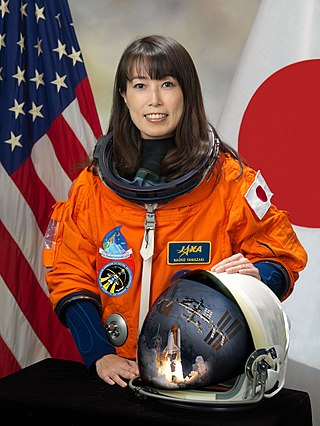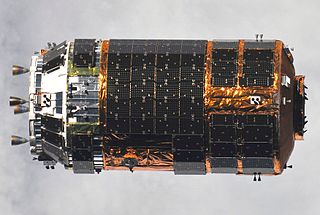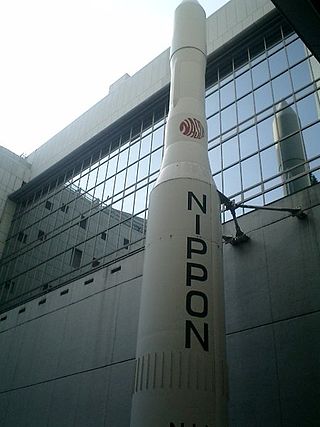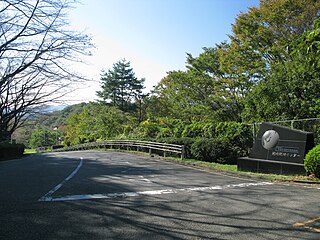
Naoko Yamazaki is a Japanese engineer and former astronaut at JAXA. She was the second Japanese woman to fly in space. The first was Chiaki Mukai.

Koichi Wakata is a Japanese engineer and a JAXA astronaut. Wakata is a veteran of four NASA Space Shuttle missions, a Russian Soyuz mission, and a long-duration stay on the International Space Station. During a nearly two-decade career in spaceflight, he has logged more than eleven months in space. During Expedition 39, he became the first Japanese commander of the International Space Station. Wakata flew on the Soyuz TMA-11M/Expedition 38/Expedition 39 long duration spaceflight from 7 November 2013 to 13 May 2014. During this spaceflight he was accompanied by Kirobo, the first humanoid robot astronaut. As of 2023, he is the longest active astronaut in the world.

The Japan Aerospace Exploration Agency (JAXA) is the Japanese national air and space agency. Through the merger of three previously independent organizations, JAXA was formed on 1 October 2003. JAXA is responsible for research, technology development and launch of satellites into orbit, and is involved in many more advanced missions such as asteroid exploration and possible human exploration of the Moon. Its motto is One JAXA and its corporate slogan is Explore to Realize.

The H-II Transfer Vehicle (HTV), also called Kounotori, is an expendable, automated cargo spacecraft used to resupply the Kibō Japanese Experiment Module (JEM) and the International Space Station (ISS). The Japan Aerospace Exploration Agency (JAXA) has been working on the design since the early 1990s. The first mission, HTV-1, was originally intended to be launched in 2001. It launched at 17:01 UTC on 10 September 2009 on an H-IIB launch vehicle. The name Kounotori was chosen for the HTV by JAXA because "a white stork carries an image of conveying an important thing, therefore, it precisely expresses the HTV's mission to transport essential materials to the ISS". The HTV is very important for resupplying the ISS because after the retirement of the Space Shuttle it is the only vehicle that can transfer new 41.3 in (105 cm) wide International Standard Payload Racks (ISPRs) and dispose old ISPRs that can fit the 51 in (130 cm) wide tunnels between modules in the US Orbital Segment.

A mission control center is a facility that manages space flights, usually from the point of launch until landing or the end of the mission. It is part of the ground segment of spacecraft operations. A staff of flight controllers and other support personnel monitor all aspects of the mission using telemetry, and send commands to the vehicle using ground stations. Personnel supporting the mission from an MCC can include representatives of the attitude control system, power, propulsion, thermal, attitude dynamics, orbital operations and other subsystem disciplines. The training for these missions usually falls under the responsibility of the flight controllers, typically including extensive rehearsals in the MCC.

The Centrifuge Accommodations Module (CAM) is a cancelled element of the International Space Station. Although the module was planned to contain several parts, the 2.5 m (8.2 ft) centrifuge still was considered the most important capability of the module.
The National Aerospace Laboratory of Japan (NAL), was established in July 1955. Originally known as the National Aeronautical Laboratory, it assumed its present name with the addition of the Aerospace Division in 1963. Since its establishment, it has pursued research on aircraft, rockets, and other aeronautical transportation systems, as well as peripheral technology. NAL was involved in the development of the autonomous ALFLEX aircraft and the cancelled HOPE-X spaceplane.

The Neutral Buoyancy Laboratory (NBL) is an astronaut training facility and neutral buoyancy pool operated by NASA and located at the Sonny Carter Training Facility, near the Johnson Space Center in Houston, Texas. The NBL's main feature is a large indoor pool of water, in which astronauts may perform simulated EVA tasks in preparation for upcoming missions. Trainees wear suits designed to provide neutral buoyancy to simulate the microgravity that astronauts experience during spaceflight.

Satoshi Furukawa is a Japanese surgeon and JAXA astronaut. Furukawa was assigned to the International Space Station as a flight engineer on long-duration missions Expedition 28/29, lifting off 7 June 2011 and returning 22 November 2011.

Akihiko Hoshide is a Japanese engineer, JAXA astronaut, and former commander of the International Space Station. On August 30, 2012, Hoshide became the third Japanese astronaut to walk in space.

The N-I or N-1 was a derivative of the American Thor-Delta rocket, produced under license in Japan. The N stood for "Nippon" (Japan). It used a Long Tank Thor first stage, a Mitsubishi Heavy Industries-designed LE-3 engine on the second stage, and three Castor SRMs. Seven were launched between 1975 and 1982, before it was replaced by the N-II. Six of the seven launches were successful, however on the fifth flight, there was recontact between the satellite and the third stage, which caused the satellite to fail.

Takuya Onishi is a Japanese astronaut who was selected for the Japan Aerospace Exploration Agency (JAXA) in 2009. He spent four months on board the International Space Station in 2016.

The Earth Observation Center is a Japanese Aerospace Exploration Agency (JAXA) aeronautical research facility located in Hatoyama, Saitama, Japan. It utilizes remote sensing technologies such as satellites to study Earth's environment from outer space. The research done by this center has a substantial impact on the study of the Earth's environmental phenomena, such as global warming.

Chōfu Aerospace Center is the headquarters and main development facility for the Japan Aerospace Exploration Agency (JAXA).

The Japanese space program originated in the mid-1950s as a research group led by Hideo Itokawa at the University of Tokyo. The size of the rockets produced gradually increased from under 30 cm (12 in) at the start of the project, to over 15 m (49 ft) by the mid-1960s. The aim of the original research project was to launch a man-made satellite.
The Monitor of All-sky X-ray Image (MAXI) is an X-ray telescope mounted on the International Space Station since 2009. The instrument uses wide field of view X-ray detectors to perform a sky survey, measuring the brightness of X-ray sources every 96 minutes.

Martian Moons eXploration (MMX) is a robotic space probe set for launch in 2026 to bring back the first samples from Mars' largest moon Phobos. Developed by the Japan Aerospace Exploration Agency (JAXA) and announced on 9 June 2015, MMX will land and collect samples from Phobos once or twice, along with conducting Deimos flyby observations and monitoring Mars's climate.
UBAKUSAT was a Turkish nanosatellite that was developed by Istanbul Technical University. It was launched into space on board a Falcon-9 rocket in April 2018 and was deployed into its orbit from the International Space Station in May 2018. It was built as a technology demonstration and Earth observation satellite to provide voice communications for amateur radio stations around the world. It carried an experimental card, TAMSAT Simplesat, which allowed scientists to test its accuracy of measuring radiation from space. It was the fifth satellite to be built by students of Istanbul Technical University.

The project to create the International Space Station required the utilization and/or construction of new and existing manufacturing facilities around the world, mostly in the United States and Europe. The agencies overseeing the manufacturing involved NASA, Roscosmos, the European Space Agency, JAXA, and the Canadian Space Agency. Hundreds of contractors working for the five space agencies were assigned the task of fabricating the modules, trusses, experiments and other hardware elements for the station.
HERACLES is a planned robotic transport system to and from the Moon by Europe (ESA), Japan (JAXA) and Canada (CSA) that will feature a lander called the European Large Logistic Lander, a Lunar Ascent Element, and a rover. The lander can be configured for different operations such as up to 1.5 tons of cargo delivery, sample-returns, or prospecting resources found on the Moon.


















